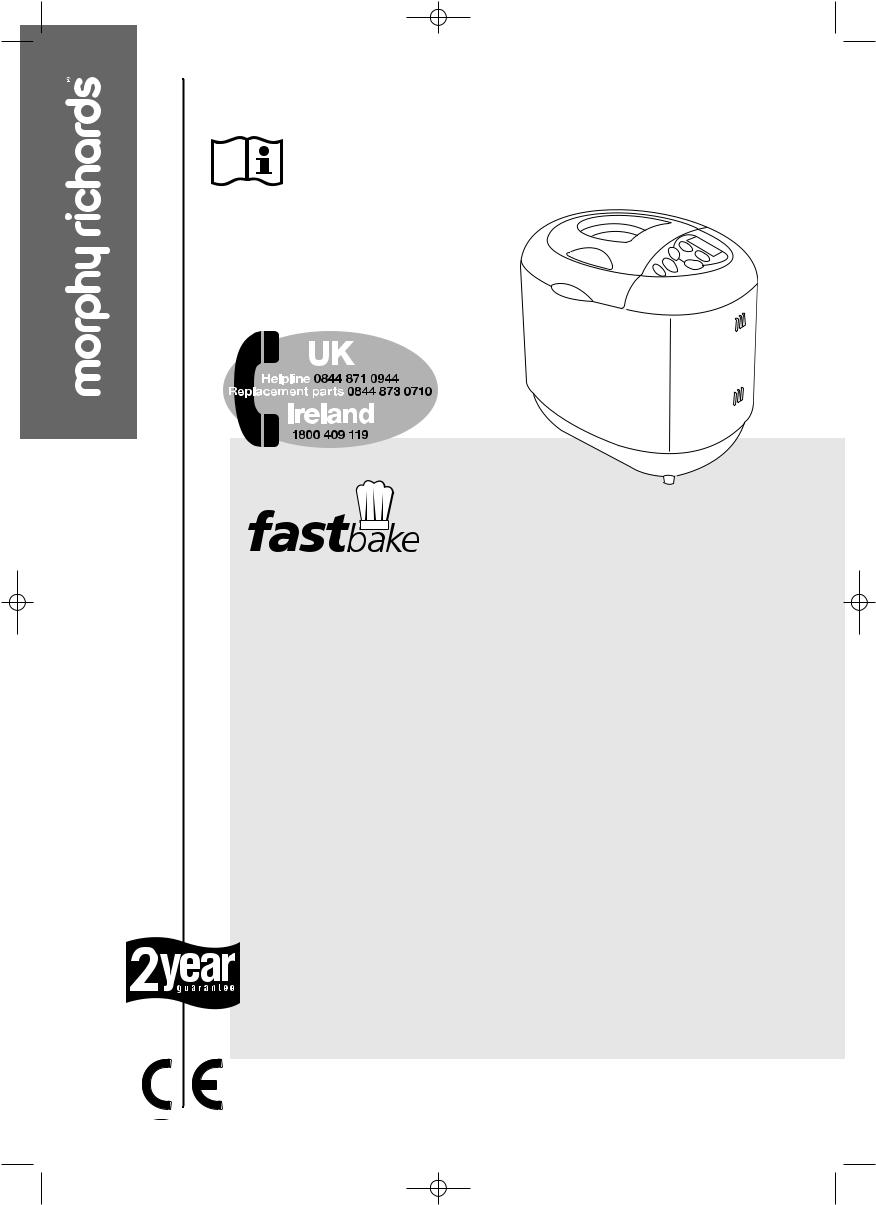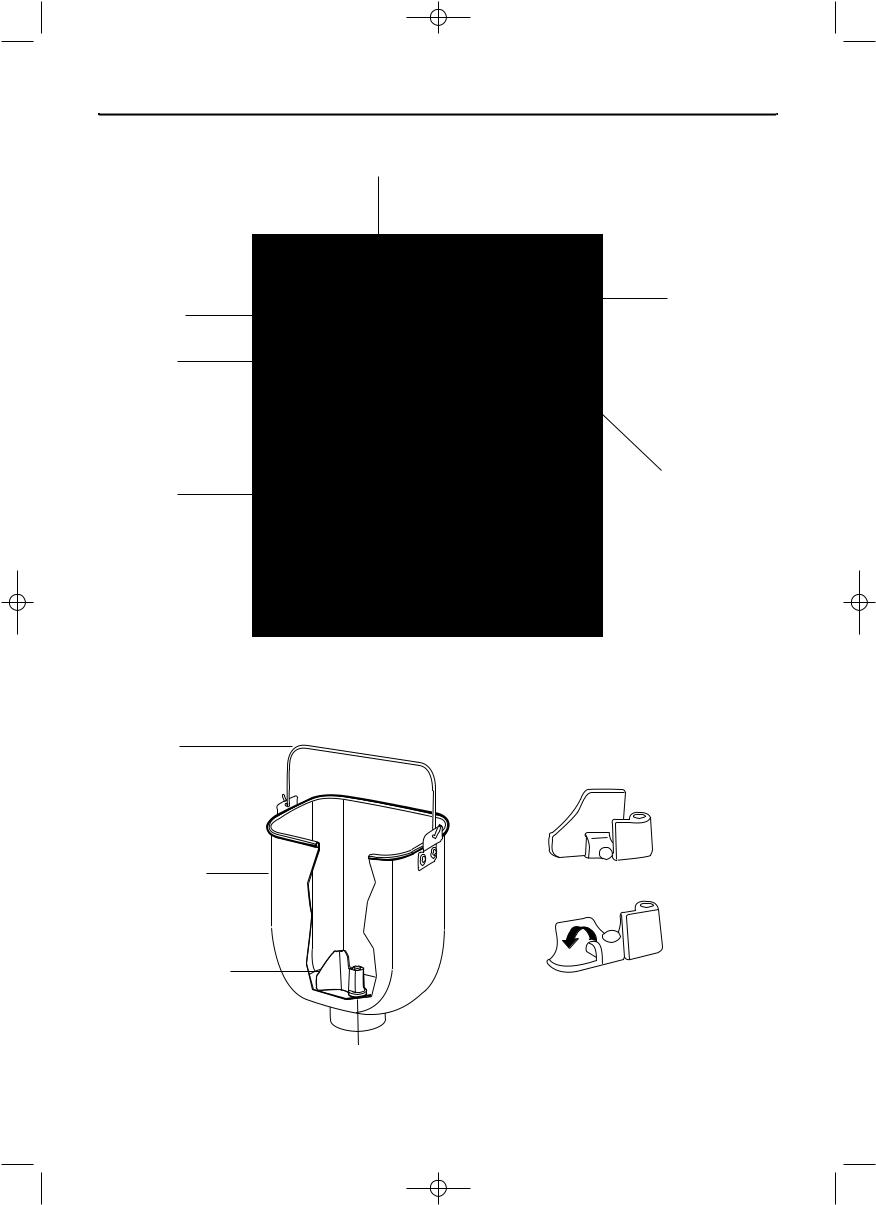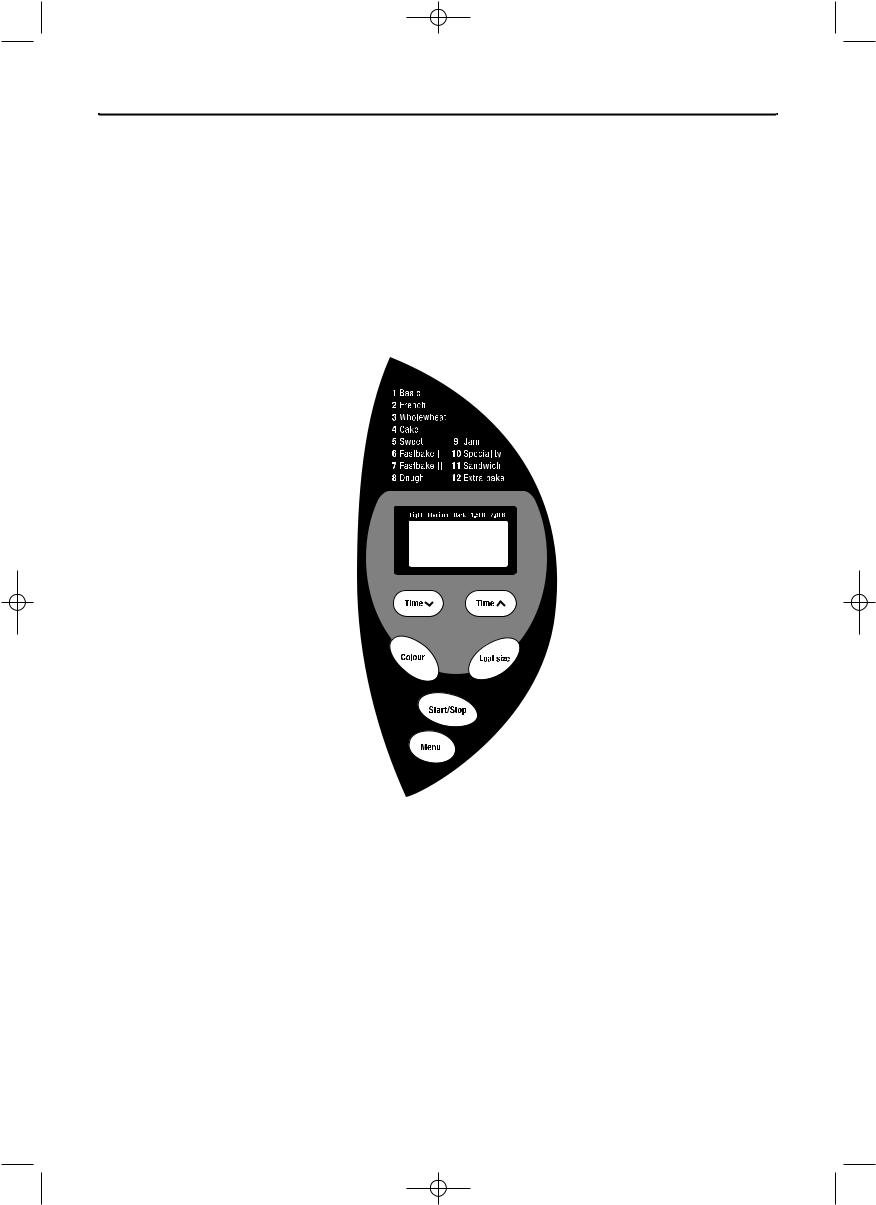Morphy Richards 48268 User Manual

48268 Rev 3 11/9/08 15:13 Page 1
Stainless steel breadmaker
Please read and keep these instructions
getting the best from
your new breadmaker...
Accurate measuring is essential
It is essential to measure ingredient quantities carefully, even slight changes may effect loaf quality.
Yeast content
If the loaf rises too high and then collapses, ensure the ingredients were measured accurately. If the problem persists, reduce the yeast by a quarter of a teaspoon.
www.morphyrichards.com

48268 Rev 3 11/9/08 15:13 Page 3
Important safety instructions
The use of any electrical appliance requires the following of basic common sense safety rules.
Primarily there is danger of personal injury and secondly the danger of damage to property and the appliance. These are indicated in the text by the following two conventions:
WARNING: Danger of personal injury
IMPORTANT: Damage to the appliance
In addition, we offer the following essential safety advice.
Location
•Remove all packaging and retain for future reference.
•Always locate your appliance away from the edge of a worktop.
•Ensure that the appliance is used on a firm, flat surface.
•Do not use outdoors or near water.
Mains lead
•The mains lead should reach from the socket to the base unit without straining the connections.
•Do not let the mains lead hang over the edge of a worktop where a child could reach it.
•Do not let the lead run across an open space e.g. between a low socket and table.
•Do not let the lead run across a cooker or toaster or other hot area which might damage the cable.
•If the supply cord is damaged, it must be replaced by the manufacturer, it’s service agent or similarly qualified persons in order to avoid a hazard.
Your safety
•WARNING: Do not touch hot surfaces. Use oven mitts or oven gloves when removing the hot bread pan. Do not cover the steam vent openings under any circumstances.
•WARNING: Avoid contact with moving parts.
•WARNING: To protect against electrical shock, do not immerse the cord or plug in water or other liquid.
•Extreme caution must be observed when moving an appliance with hot contents.
•Do not use the breadmaker for storage purposes nor insert any utensils, as they may create a fire or electric shock hazard.
•Do not use use the appliance with wet or moist hands.
Children
•Never allow a child to operate this appliance. Children are vulnerable in the kitchen, particularly when unsupervised and if appliances are being used or cooking is being carried out.
•Teach children to be aware of dangers in the kitchen, warn them of the dangers of reaching up to areas where they cannot see properly or should not be reaching.
•Children should be supervised to ensure that they do not play with the appliance.
Other safety considerations
•If the mains lead of this appliance is damaged, do not use it. The lead may only be replaced by Morphy Richards Ltd or an agent of the company, since special purpose tools are required. Telephone Morphy Richards helpline for advice.
•The use of accessory attachments not recommended by the manufacturer may cause damage to the breadmaker.
•Do not place the appliance on or near heat sources such as gas or electric stove ovens, or burners.
•To avoid damaging the appliance, do not place the baking pan or any object on top of the unit.
•Do not clean with scouring pads. Do not wash the baking pan, kneading blade, measuring cup or spoon in a dishwasher.
•Keep the appliance and the cable away from heat, direct sunlight, moisture, sharp edges and the like.
•The baking pan must be in place prior to switching on the appliance.
•Always remove the plug from the socket whenever the machine is not in use, when attaching accessory parts, cleaning the machine, or whenever a disturbance occurs. Pull on the plug, not the cable.
•This appliance is not intended to be operated by means of an external timer or separate remote control system.
•This appliance is not intended for use by persons (including children) with reduced physical, sensory or mental capabilities or lack of experience and knowledge unless they have been given supervision or instructions concerning the use of the appliance by a person responsible for their safety.
2

48268 Rev 3 11/9/08 15:13 Page 4
Contents
Operating instructions
Important safety instructions |
2 |
Introduction |
4 |
Before first use |
4 |
Electrical requirements |
4 |
About this breadmaker |
4 |
About the recipes |
4 |
Components |
5 |
Control panels buttons, display and functions |
6 |
Program descriptions |
7 |
Using your breadmaker |
8 |
Using the timer |
9 |
Beeper |
9 |
Power interruption |
9 |
Slicing and storing bread |
9 |
Drop down blade |
9 |
Care and cleaning |
10 |
Storing the unit |
10 |
Know your ingredients |
11 |
Measuring ingredients |
12 |
Ingredient temperatures |
13 |
Creating your own yeast breads |
13 |
Special glazes for yeast breads |
13 |
Other tips |
13 |
Recipes |
|
Basic breads |
|
Basic white bread |
14 |
Softgrain bread |
14 |
Brown loaf |
14 |
Italian herb bread |
14 |
Cheese & onion bread |
14 |
Raisin bread |
14 |
Sun-dried tomato loaf |
14 |
French bread |
15 |
Wholewheat breads |
|
Wholewheat bread |
15 |
Granary loaf |
15 |
Cake setting |
|
Madeira cake mix |
15 |
Mixed fruit cake |
15 |
Banana and nut bread |
16 |
Porridge oats bread |
16 |
Sweet |
|
Mixed fruit loaf |
16 |
Chocolate bread |
16 |
Fastbake I |
|
Fastbake small white |
16 |
Fastbake II |
|
Fastbake large white |
16 |
Dough recipes |
|
White bread rolls |
17 |
Wholewheat bread rolls |
17 |
Hot cross buns |
17 |
Pizza base |
17 |
Jams |
|
Marmalade |
17 |
Raspberry and apple |
17 |
Speciality |
|
Malt loaf |
18 |
Sandwich |
|
Sandwich loaf |
18 |
Softgrain sandwich loaf |
18 |
Gluten free recipes |
|
Gluten free loaf |
19 |
Gluten free madeira cake |
19 |
Bread mixes |
19 |
Further information
Conversion chart |
20 |
Baking cycle times |
21 |
Need help? (questions and answers) |
22 |
Troubleshooting |
24 |
3

48268 Rev 3 11/9/08 15:13 Page 5
Introduction
The smell of homemade bread wafting around the home is one of those great smells. Bread, fresh out of the oven, with melting butter is a memorable taste sensation. The Morphy Richards automatic breadmaker can create that experience every morning.
There's very little effort on the part of the baker, because the breadmaker is a sophisticated appliance with a computer memory that does all the work for you.
It’s as simple as one-two-three.
1Put in the ingredients.
2Select program from the menus and press start.
3Wait for your bread.
But don't stop at baking bread in this appliance.
Besides being able to do all kinds of speciality breads, including wholewheat, you can also prepare doughs for bread rolls, pizza, cake and jam. Everything is easy and tastes homemade - because it is.
Before first use
Before first use, please take a few minutes to read this instruction book and to find a place to keep it handy for reference. Pay particular attention to the safety instructions.
1Carefully unpack the breadmaker and remove all packaging materials.
2Remove any dust that may have accumulated during packing.
3Wipe the baking pan, kneading blade and outside surface of the breadmaker with a clean, damp cloth. The bread pan is non-stick coated. Do not
use scouring pads or any abrasives on any part of the breadmaker.
4For first time, use oil, butter or margarine to grease the bread pan and bake empty for about 10 minutes (select the Extrabake program).
5Clean once more.
6Place the kneading blade on the axle in the baking pan.
During manufacturing, it is necessary to lightly
grease some parts of the appliance. This may result in the unit emitting some vapour when first used, this is normal.
Electrical requirements
Check that the voltage on the rating plate of your appliance corresponds with your house electricity supply which must be A.C. (Alternating Current).
If the socket outlets in your home are not suitable for the plug supplied with this appliance, the plug should be removed and the appropriate one fitted.
WARNING: The plug removed from the mains lead, if severed, must be destroyed, as a plug with bared flexible cord is hazardous if engaged into a live socket outlet.
WARNING: This appliance must be earthed.
Should the fuse in the 13 amp plug require changing, a 13 amp BS1362 fuse must be fitted.
About this breadmaker
•It has two settings to make a small 680g (1.5lb) or large 907g (2lb) loaf (approximate weight - depends on recipe).
•A Fruit and Nut beep signals when extra ingredients can be added so they don’t get chopped by the kneading blade.
•The 1.5lb setting can be used to make a 1lb loaf for some of the recipes.
About the recipes
The recipes in this booklet have been thoroughly tested to ensure best results. Recipes have been created by home economists specifically for this machine and may not produce acceptable results in other similar machines.
•Always add ingredients in the order they are listed in the recipe.
•Accurate measuring of ingredients is vital. Do not use larger amounts.
4

48268 Rev 3 11/9/08 15:13 Page 6
Components
Viewing window
Control panel
Cover
Lid handle
Air vents
Main body
Handle |
Blade has two positions |
Upright position
Baking pan
Down position
Kneading blade
Rotating shaft
5

48268 Rev 3 11/9/08 15:13 Page 7
Control panel buttons, display & functions
Display window
Shows browning level selected Shows weight selected
Shows the program number Shows time left before completion
(for example, 3:20 is 3 hours and 20 minutes; 0:20 is 20 minutes)
Shows temperature warning - see ‘Troubleshooting’
Timer delay buttons
Use to delay the start of bread making (all programs except Fastbake)
Start
Press to start, for approximately 1 second, a beep sounds and the colon (:) flashes and the program starts
Stop
Press to stop, for approximately 2 seconds, a beep sounds to confirm
Colour button
For selecting crust colour from light, medium or dark (certain programs only)
Menu button
For choosing the bread making program from the list 1 to 12
Loaf size button
For selecting small (1.5lb) or large (2lb) loaf size (certain programs only)
6

48268 Rev 3 11/9/08 15:13 Page 8
Program descriptions
1Basic white (3:00 and 2:53)
For white and brown bread. Also for flavoured breads with added herbs and raisins.
2French (3:50 and 3:40)
For the baking of light weight bread, such as french bread which has a crisper crust and light texture.
3Wholewheat (3:40 and 3:32)
For the baking of bread containing significant amounts of wholewheat. This setting has longer preheat time to allow the grain to soak up the water and expand. It is not advised to use the delay timer as this can produce poor results. Wholewheat usually produces a crispy thick crust.
4Cake (1:40)
This setting will mix ingredients and then bake for a preset time. It is required to mix two groups of ingredients in bowls before adding to the breadmaker (see cake recipes).
5Sweet (2:55 and 2:50)
For the baking of sweet type bread which gives a crisper crust than on basic setting. The crisper crust is produced by the sugar ‘burning’.
6Fastbake I (1:10)
For preparation of a 1.5lb white loaf in a reduced time period. Loaves made on this setting can be shorter and the texture more moist.
7Fastbake II (1:15)
For preparation of a 2lb white loaf in a reduced time period. Loaves made on this setting can be shorter and the texture more moist.
8Dough (1:30)
This setting only makes the dough and will not bake the final bread. Remove the dough and shape it to make bread rolls, pizza, etc. Any dough can be prepared on this setting. Do not exceed 1kg (2lb) of combined ingredients.
9Jam (1:20)
Use this setting for making jam from fresh fruits and marmalade from Seville oranges. Do not increase the quantity or allow the recipe to boil over the pan into the baking chamber. Should this happen, stop the machine immediately. Remove the pan carefully, allow to cool a little and clean thoroughly.
10Speciality (2:50)
For bread types that are required in a shorter time. Bread baked on this setting is usually smaller with a dense texture.
11Sandwich (3:00 and 2:55)
This is to bake light texture bread but with a softer but thicker crust.
12Extra bake (0:10)
This setting is bake only and can be used to increase the baking time on selected settings. This is especially useful to help ‘set’ jams and marmalade. When started, the default time is 10 mins (0:10) minimum and counts down in 1 minute intervals. You will have to manually switch this off, by pressing the stop button, when you have completed the extrabake process. It is advised that you check the condition of the bread or jam after 10 minutes and at 10 minute intervals.
Pressing ▲ increases the time in increments of 10 minutes up to a maximum 1 hour.
Do not use the extrabake programme for more than 1 hour, as over heating of the product may occur.
7

48268 Rev 3 11/9/08 15:13 Page 9
Using your breadmaker
1Take out the pan
Open the lid and remove the pan by lifting the handle, turning anti-clockwise and lifting out. Place on the work surface. It is important that the pan is filled with ingredients outside the machine so that any accidental spillage is not ignited by the heating elements.
2Attach the blade
Attach the kneading blade to the shaft by pushing on. Ensure the blade is in the upright position before adding ingredients shown on page 9.
3Measure ingredients
Measure the ingredients required and add them all into the pan in the order listed. See later section (‘Measuring your ingredients’).
•When adding the yeast to the baking pan, take care that the yeast does not come into contact with the water or any other liquid, as it will start to activate immediately.
•Use tepid water 21-28oC.
4Put pan back in
Place the baking pan back in the breadmaker, turning clockwise to lock into place. Close the lid.
5Plug in
Plug into the power supply. The breadmaker will automatically be set to basic bread menu and normal time.
•Everytime you press a button you will hear a beep to confirm.
6Select program
Choose the desired setting from the list by pressing the Menu button.
7Select weight
Press Loaf size button to choose between small or large.
8Select colour
Choose desired crust colour by pressing Colour button.
9Select the delay time
If you wish the bread to be ready later, set the time delay now, as described in next section.
10Start
Press the Start Stop button to start the machine. The remaining time will count down in one minute increments.
11Progress
The breadmaker will automatically proceed through the programmed stages as shown in the ‘Baking cycle times’ section. If the breadmaker has a program selected that has a second kneading process, beeps sound to inform that fruits and/or nuts may be added.
•It is possible that steam will escape through the vents during baking, this is normal.
12Finish
When the program is completed and the bread is baked, the display shows 0:00 and the beeper will sound.
13Keep warm
The keep warm function will circulate hot air for a further 60 minutes on most settings (see ‘Baking cycle times’ section). For best results, remove the baking pan and loaf within this period or when the initial program is completed. 10 beeps will be heard when the keep warm period is finished.
14Remove the food
Press Stop. Open the lid.
WARNING: Use oven gloves when removing the baking pan and take care as it is very hot.
15Turn out the bread
Allow the bread to cool in the pan for 15 minutes, then turn the pan upside down and tap the bread from the pan onto a rack to cool. Fill the pan with warm water immediately to prevent the blade from sticking to the shaft.
•Occasionally the kneading blade will stay in the loaf. Wait until the loaf is cool and then remove the blade with a wooden or plastic utensil to avoid damage to the non-stick surface.
16 Always unplug the appliance after use.
•Do not open the lid whilst the breadmaker is operating as this will affect the quality of the bread, especially it’s ability to rise properly. Only open the lid when the recipe needs you to add additional ingredients, see recipes.
Room temperature note
The breadmaker will work well in a wide range of temperatures, but there could be a difference in loaf size between a very warm room and a very cold room. We recommend the room temperature should be between 15oC and 34oC.
8
